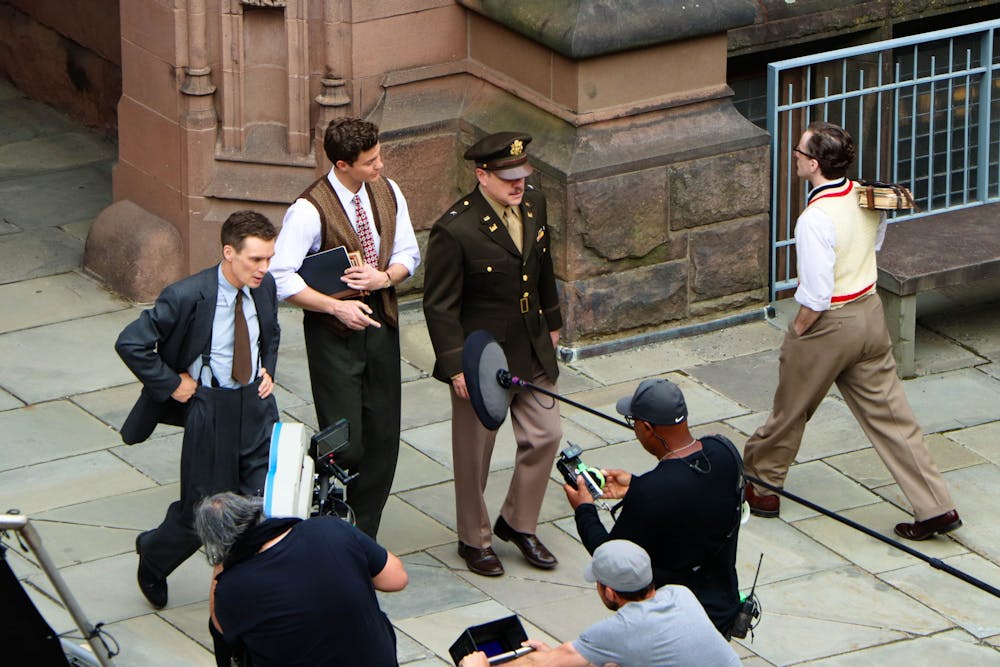It has been the summer of Princeton at the movies. The University was mentioned in the animated smash-hit “Spider-Man: Across the Spider-Verse” and Jennifer Lawrence’s hilarious “No Hard Feelings,” but only one filmmaker had the unadulterated vision to put boots on the ground, and that was the one and only Christopher Nolan. One could say that Princetonians were on the “Oppenheimer” hype-train well before the general public (all the way back in April 2022), and for good reason — it’s not every day that a Hollywood production blocks your way to language class. The scene was not one for the cutting room floor: East Pyne can be seen clearly early in the movie, and the nearby Institute for Advanced Study is the location of some of the movie’s most memorable scenes. But beyond the film’s proximity to our community and the social media frenzy of Barbenheimer, the question remains: is it any good?
I am pleased to report that yes, Christopher Nolan delivers in this excellent nuclear opus. After “Tenet,” a film that gave the impression Nolan might have forgotten the humanity required to ground his always high concept work, “Oppenheimer” is built on introspection. The central conflict of the movie is within the protagonist, J. Robert Oppenheimer, and is not the race against the Nazis or the continuous full-contact politicking. The weight of the narrative falls upon Cillian Murphy — specifically his face. Murphy’s cold blue eyes are shot on 70mm IMAX by director of photography Hoyte van Hoytema. They consume the screen and lock the viewer into the three-hour behemoth of a character study.
The movie is long, and if I had one central complaint, it is that it feels its length at certain points. The editing and music do a lot to keep the film moving at a breakneck pace, but a three-hour psychological drama about the fate of mankind takes its toll on you. However, this story deserves to be told in its entirety at the highest caliber of filmmaking, which is accomplished by Nolan. Thus, I can forgive its runtime, especially when it sticks such an accomplished landing. There were moments when I thought I would never see the end credits of this movie, but when they finally arrived, I was shaken to my core. In fact, Nolan leaves the viewer with such a haunting final message that I woke up the next morning with a pit in my stomach. More on that later.
Certainly, the film is largely the Nolan and Murphy show, but like all films, it is a team effort. Robert Downey Jr. gives an incredible supporting performance with far more screen time than I expected — this is a packed ensemble in which A-listers and Oscar winners are essentially given cameo roles. Matt Damon provides enough comedic charm to uplift the heavier scenes. Emily Blunt is wounded but strong in the role of Oppenheimer’s wife, Kitty (although the film’s female characters certainly take the backseat despite the screenplay’s insistence of their academic prowess and qualifications). Finally, as previously mentioned, the score by Ludwig Goransson and the editing by Jennifer Lame intertwine different timelines and perspectives effectively, all while building a haunting atmosphere.
J. Robert Oppenheimer is a particularly difficult character to build a film around. This is the man who introduced nuclear weapons to the world. Nolan, in a smart creative choice, takes a mixed approach to his central character. He makes it clear that Oppenheimer is manipulated by the US government. To the many bureaucrats in the film, he is simply a pawn to be used and disposed of immediately after. President Harry S. Truman even memorably calls him a crybaby. The audience can root for a man against the might of McCarthy era anti-communist fervor.
On the other hand, Oppenheimer is an impulsive, erratic spirit. He is a serial adulterer and, in an early scene involving a tutor’s apple and some cyanide, someone capable of impulsively committing acts of violence. Such is the hypocrisy of J. Robert Oppenheimer; he lacks foresight and self-control, but then laments his actions afterward. He creates the atomic bomb, but only questions its use after it drops. Like the flaming column of a mushroom cloud, Oppenheimer burns bright, but he is caught off-guard by the shockwave that follows. Nolan understands the contradiction and does not let the man off easily.
The film ends with a horrifying prediction. Each character would like to believe that they dropped the atom bomb and got away with it. The sky did not combust, the world did not end. They can grow old and rest on their laurels — content with the global peace that followed World War II. However, Nolan argues that the shoe has yet to drop. That the future is more foreboding than the past ever was. It is forever disturbed, like raindrops falling on a still pond.
Tyler Wilson is a senior contributor for The Prospect and Humor at the ‘Prince.’ He can be reached at tyler.wilson@princeton.edu, or on Instagram at @tylertwilson.








